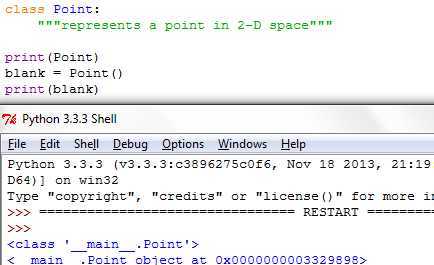标签:style blog http io ar for 2014 sp cti
We have used many of Python’s built-in types; now we are going to define a new type. As an example, we will create a type called Point that represents a point in two-dimensional space.
In mathematical notation, points are often written in parentheses with a comma separating the coordinates. For example, (0,0) represents the origin, and (x,y) represents the point x units to the right and y units up from the origin.
There are several ways might represent points in Python:
Creating a new type is more complicated than other options, but it has advantages that will be apparent soon. A user-defined type is also called a class. A class definition looks like this:

This header indicates that the new class is called Point. The body is a docstring that explains what the class is for.

Because Point is defined at the toplevel, its ‘full name’ is __main__.Point. The class object is like a factory for creating objects. To create a Point, you call Point as if it were a function. The return value is a reference to a Point object, which we assign to blank. Creating a new object is called instantiation, and the object is an instance of the class.
from Thinking in Python
标签:style blog http io ar for 2014 sp cti
原文地址:http://www.cnblogs.com/ryansunyu/p/3989516.html